


























MIAMI J u n e 8 & 9
Pop-Up Concierge Visits: By Appointment Only








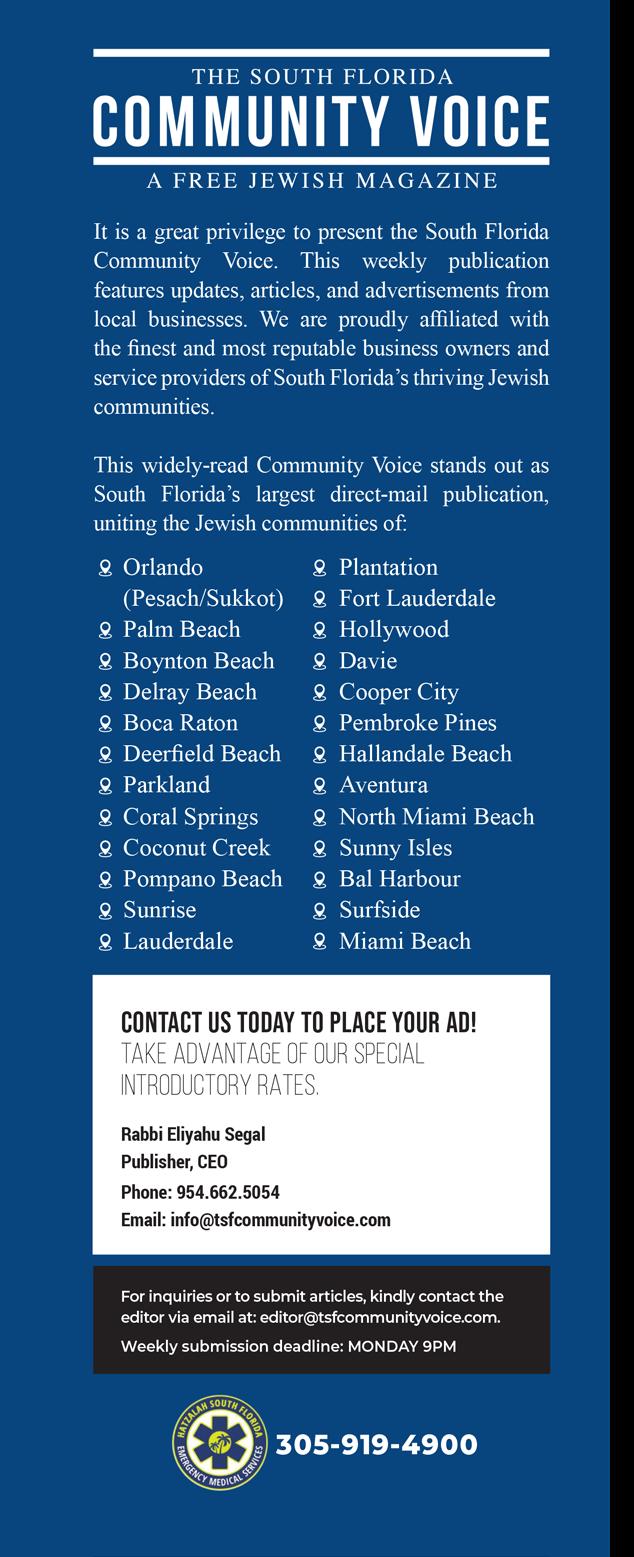

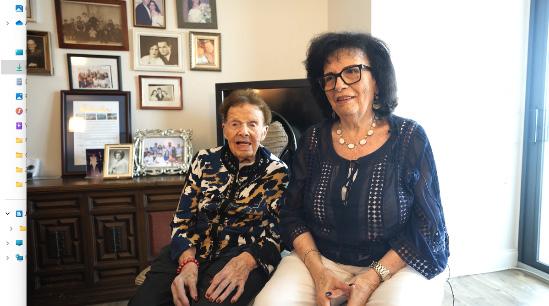


© The South Florida Community Voice Magazine. All rights reserved. Reproduction in printed or digital form in whole or in part in any form without prior written permission is prohibited. The publisher reserves all right to edit all articles for clarity, space and editorial sensitivities. Submissions cannot be returned to sender. The South Florida Weekly Magazine is not responsible for the cash flow of any advertised product or service that appears in these pages. The South Florida Community Voice Magazine assumes no responsibility for the content of articles or advertisements in this publication, nor for the content of books that are referred to or excerpted herein.


By Sivan Rahav Meir
After Shavuot: Carrying the Torah Forward
Timeless Blessings
Parashat Naso, the longest parashah in the Torah, contains the famous, powerful blessing of Birkat Kohanim. Aaron Hakohen and his sons were given the mitzvah to bless the Jewish People, and to this very day, the Kohanim in every congregation bless the Jewish people every holiday (and, in Israel, every day!) with these same words. Traditionally, parents also bless their children on Friday night with these words:
May Hashem bless you and protect you. May Hashem make His face shine on you and be gracious to you. May Hashem turn His face toward you and give you peace.
The following story connects the timeless words of Birkat Kohanim with a modern-day discovery:
“This is so boring!” one boy groaned, kicking at a pile of small stones. “When is this club going to end already?”
Dr. Gabi Barkay, the club’s director, was losing patience. A seasoned archaeologist, Dr. Barkay had spent decades studying ancient vessels and ruins to better understand Israel’s past. Forty years ago, he founded an archaeology club for 12- and 13-year-olds, hoping to spark their interest in history. That day, he had brought the group to a modest excavation site in Jerusalem—not a location

anyone expected to yield much of significance. As Dr. Barkay attempted to give his lesson, the boy’s constant interruptions grew more disruptive.
“He was a real nuisance,” Barkay later recalled. “I didn’t know what to do with him! Finally, I said, ‘If it’s too hard for you to listen, just go into that cave over there and clean the rocks.’”
Like the other caves at the site, the one he pointed to was assumed to be empty.
But a few minutes later, the boy returned and tugged at Barkay’s shirt. When the archaeologist turned around, he was stunned. In the boy’s hands were two intact pottery vessels—clearly from the period of the first Beit Hamikdash.
“He wasn’t supposed to touch them,” Barkay admitted. “He was supposed to call me. But at that moment, I had no idea that this boy would lead me to the most important discovery of my career.”

The boy showed him the exact spot where he had found the vessels. Overcome with excitement, Barkay began to investigate further—and quickly unearthed an entire cache of ancient artifacts buried in the same area.
He sent the children home and summoned a team of professional archaeologists. Working day and night, they uncovered more than 1,000 objects: pottery bowls, iron arrowheads, and over 100 silver items—all from the same cave.
Among the treasures was a tiny gray cylinder, barely two centimeters long. Once cleaned, it revealed itself to be an ancient silver scroll. Rolled tightly and sealed shut, it had been written over two millennia ago.

The scroll was sent to a specialized lab at the Israel Museum. So delicate was the artifact that it took researchers three years to develop a safe way to unroll it without destroying the inscription inside.
When it was finally opened, Barkay examined it under a highpowered microscope. “Suddenly, a word jumped out at me,” he recalled. “It was the name of Hashem. Then I realized—I was holding a copy of Birkat Kohanim.”
Painstakingly, the researchers deciphered the text, written in ancient Hebrew script. It was indeed the Birkat Kohanim, preserved for thousands of years. As Barkay put it, it felt like a greeting from their ancestors who had lived in Jerusalem at the time of the Beit Hamikdash.
The scroll remains the oldest known biblical text ever discovered in Israel. Its discovery served as powerful evidence of the deep, ancient connection between Am Yisrael and Eretz Yisrael. Scholars around the world were captivated. Articles were published. Debates ensued. Experts traveled to see the scroll in person. Yet one detail was left out of every academic report: The entire discovery had started with a bored schoolboy on a dusty day in Jerusalem.
Parashat Naso tells us about the logistics of journeying in the wilderness. The Torah relates which tribe was responsible for carrying which item of the Mishkan, and how various elements were disassembled when Bnei Yisrael moved from one place

to the next.
None of this could be achieved without discipline, organization, and order. If the physical moves are not done in the correct order, the content on the inside will be correspondingly flawed.
Some people think that spirituality means “going with the flow,” and freeing yourself from any obligations so that you can do what you want when you feel like it. Rabbi Yerucham Levovitz, one of the great spiritual leaders in prewar Europe who headed the Mir yeshivah, explained why a person can reach spiritual heights only within an orderly framework:
Order, which on its own is not important, helps preserve all the good in the world. Order is an important virtue, and is possibly the most important one. When we use order to regulate our spiritual life and help us keep the Torah and its laws then it certainly influences a person to be better. Someone who lives without order is missing the chance for perfection and wholeness.




Washington, D.C. — When Eduardo Kornworcel, a Boston University student from Florida, walked the halls of Congress last week, it wasn’t just a tour; it was a bold step in the relentless fight he’s leading on campus to confront rising antisemitism and anti-Israel hostility.
As a fellow in the Orthodox Union’s Leaders in Advocacy Training (LIAT) Fellowship, Eduardo joined an elite cohort of Jewish student leaders from across the country for an intensive week in Washington, D.C., armed with tools, strategy, and resolve to escalate their advocacy from campus battlegrounds to the national stage. The experience marked a critical turning point in the fight for a safer, stronger future for Jewish students in America.
“Meeting leaders from every sector who shape our communities and hearing their strategies to build bipartisan coalitions has
been an eye-opening experience. I’m ready to bring what I have learned back to campus and unite students against the growing tide of antisemitism and anti-Israel sentiment,” Eduardo said.
In response to the dramatic surge in campus antisemitism after October 7, the Orthodox Union launched the LIAT Fellowship to forge an army of fearless student advocates, leaders equipped not just to respond but to dismantle hate with precision, innovation, and unyielding courage.
The urgency of this mission hit home in D.C. when, just blocks from where the fellows were meeting, a radical antisemite murdered two Israeli Embassy employees, an act of hate that chillingly echoed the threats these students face back on campus.
These fellows are rewriting the rulebook: forging unlikely alliances, working with university admin-
istrations to follow federal civil rights law, and launching dynamic campaigns to counteract BDS propaganda and anti-Israel disinformation.
Eduardo stands at the forefront of this movement. Alongside University of Maryland student Lucy Schneider, he co-founded AntisemitismOnCampus.net, a pioneering website and hotline that connects students directly with the Anti-Defamation League to report antisemitic incidents. The platform has become a vital lifeline for students facing antisemitic hate.
In addition, Eduardo developed a comprehensive fact sheet breaking down the connection between antisemitism and antizionism, exposing how they feed off each other, and revealing the dangerous impact of the BDS movement. His creative flyers, featuring watermelon and Palestinian flag imagery,














cleverly counter campus disinformation and redirect students to his site, educating them with clarity and facts.
These initiatives are part of the required “capstone project” each LIAT fellow completes. At Binghamton University (SUNY), fellows helped secure the appointment of a Title VI coordinator and the introduction of mandatory civil rights training for faculty and staff—a first for the campus. At Cornell, a fellow led a campaign that gathered more than 5,000 signatures, successfully pressuring the university to cancel a concert by an artist with a history of antisemitic remarks.
The D.C. summit was a chance for these leaders to unite, reflect, and strategize on how to carry their work forward across
campuses nationwide.
In Washington, Eduardo and his peers brought their determination to Capitol Hill. They met with senior White House officials, State Department leaders, and legal champions such as Judge Matthew Solomson, the first Orthodox Jewish Chief Federal Judge. They were briefed by Israeli Deputy Chief of Mission Eliav Benjamin, engaged in dialogue with interfaith partners, and met influential members of Congress, including Rep. Randy Fine (R-FL), Rep. Dan Meuser (RPA), and Rep. Jared Moskowitz (D-FL), discussing key legislation like the Antisemitism Awareness Act and measures to counter Iran’s threat.
“These students are among the most visionary and
courageous advocates we’ve ever encountered,” said Nathan Diament, Executive Director of the OU Advocacy Center. “Their moral clarity and strategic leadership are urgently needed to protect the Jewish community and strengthen our country.”
Policymakers took notice.
“If these students step into government, America will be in good hands,” said Daniel Marrow, Legislative Director for Congresswoman Laura Gillen (NY-04).
For Eduardo, the week in Washington was not the beginning, and it’s certainly not the end. When he returns to Boston University this fall, he and his fellow LIAT advocates will continue their mission with renewed clarity, strength, and an unbreakable commitment to justice.



























By Dr. Chaim Y. Botwinick
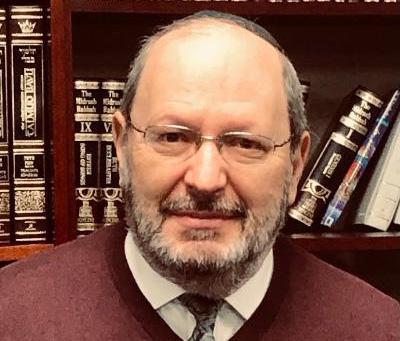
Given the extensive nature of this topic, this article is presented as a two-part series. Part II will be publishedinnextweek’sEditionof SouthFloridaCommunityVoice
In a 2022 blog entitled The Senior Leadership Turnover Crisis in our Jewish Day Schools and Yeshivot (Times of Israel, November 1, 2022), I referenced several factors which contribute to the ever-increasing senior professional leadership turnover crisis in our Jewish day school and yeshivot.
Since that blog was posted, I received numerous reactions, from both yeshiva and day school professionals and laity. With the exception of several critical and somewhat less than positive feedback, the responses were overwhelmingly positive and quite meaningful.
Most of the comments and reactions focused less on the nature of the Jewish day school leadership profession per se, but rather upon the role, impact and effect of Board leadership on the health, effectiveness, welfare, retention and
stability of yeshiva and day school professional leadership.
The Context:
It is important to note that one should never paint a portrait with broad brush strokes. There are always exceptions to every circumstance. Here too, the portrait which I am painting is comprised of a landscape which is colored with a mosaic of amazing day school and yeshiva successes, accomplishments and impact. But as we know, it is also a field fraught with daunting challenges.
Besides for ongoing exigencies facing our schools relating to financial viability, affordability, hashkafa, and the paucity of high quality teaching and administrative personnel, there is a growing crisis in leadership on the board (lay) level. This crisis is not necessarily quantitative in nature, but one which is qualitative on a variety of levels.
In many cases, the financial support and viability of our yeshivot and Jewish day schools are derived from very generous, sincere and passionate Board members who unfortunately lack a variety of Board leadership skills and training. This lack of training and experience can be resolved in part by requiring them to participate in Board leadership skills training. But, reality dictates that training alone may not be sufficient to change a Board member’s personal demeanor, personality or disposi-
tion, let alone behavior patterns. As a result, these leaders may require a special one-on-one conversation with the school board president, chair of the board of directors or Rosh HaYeshiva regarding the expectations of a Board member and the imperative for trustees to act and behave appropriately and respectfully towards the head of school and/or principal.
In my practice as senior executive leadership coach, I now hear, more often than ever, complaints about board leadership and their profound lack of leadership skills or their lack of understanding or an appreciation and respect for professional boundaries, roles and responsibilities. This reality is exacerbated and by an unswerving and a continuous desire and need to micromanage senior school leadership. This is in addition to the manner in which a growing number of inexperienced trustees publically and privately talk and address concerns behind closed doors, regarding their school’s senior educational leadership.
These toxic realities represent a growing problem and dilemma for our schools. On the one hand, our institutions are in desperate need of continued financial support and resources from these very individuals; on the other hand, these institutions must continuously maintain positive working relationships with generous donors and financial champions, irrespective of their character, demeanor,



Sunday to Thursday: 12pm - 10pm Friday: 11am - 3:30pm OPENING HOURS Scan the code to order!


inappropriate style or temperament or lack of training.
The consequences resulting from this growing disconnect and dissonance is daunting at best. Although philanthropic support benefits the school financially, donor dysfunctionality can have a devastating effect on the culture of our schools and a lasting effect on senior professional leadership who are entrusted by the community with the responsibility to lead our institutions.
This growing level of mistrust, disharmony and dysfunctionality usually results in either the head of school or principal leaving the school on his/her own volition, is let go in a very well-orchestrated and politically correct manner; or the professional is just out-right dismissed or from his/her leadership post. Alternatively, there are those whose contacts are not renewed and let the chips fall where they may.
In addition, to the growing number of professional leadership vacancies this creates, it leaves a trail of senior professional leadership departures which are detrimental to the reputation and stability of our yeshivot and day schools, In fact, the average tenure for a Jewish day school or yeshiva principal or Head of School is about five years – not a very attractive or inviting profession.
Finally, I would be remiss in my analysis if I were to not suggest that there are many instances when professional school leadership deficiencies or poor professional leadership and/or management performance lead to dismissal. Moreover, not all heads of school or principals have the skill-set, bandwidth, knowledge or experi-
ence required to work effectively with school board lay leadership or for that matter lead a school. This challenge requires further discussion, study, review and analysis.
At the end of the day, this reality does not justify, excuse or eclipse the growing toxicity created when members of the school board do not carry out their mandated leadership responsibilities with derech eretz or kavod for the very senior professionals they recruited and hired.
As we know, parents are extremely sensitive and impressionable when it comes to their children’s schooling. If they observe a lack of respect or derech eretz emanating from members of the Board towards the school’s administration (or faculty), then there is no reason why they should not follow suit. It’s all about setting examples, modeling and support“leadership leads”.
I have heard on more than one occasion where parents will complain directly to a Board member regarding an academic issue, teacher or child-related concern as opposed to approaching the head of school or principal. One can only imagine how this interference and confusion of roles can spiral out of control within in a period of hours.
In these select cases, it’s impossible to prevent parents from ignoring appropriate protocol or practices. Nevertheless, it is should be the Board members responsibility and obligation to inform the parent that the issue or concern must be directed to the head of school or principal. Once the Board member takes it upon himself or herself to address this issue,
it not only compromises the role of the professional, but sets a terrible precedence for similar actions in the future.
Way many too many board members have the urge to leave their respective leadership roles in order to consciously or subconsciously “play” head of school, principal or supervisor. Over a very short period of time this behavior creates confusion, chaos, compromise and toxicity let alone a public lack of faith and trust in the senior professional leadership of the school.
Finally, reason attributed to Board members assuming these self-empowering roles is a topic which also requires a deep dive. In most cases it’s the result of a need to control as opposed to leading.
At the end of the day, it is imperative for the senior administrative team in partnership with the school Board Executive committee to address this issue post haste in order to prevent it from spreading out of control.
Part II of this article will focus on select factors and variables which impact upon board effectiveness; board strengths and weaknesses; and several solutions in order to enhance the role, responsibility and impact of the Board on the on school viability and effectiveness
Dr. Chaim Botwinick is a senior executive coach and an organizational consultant. He served as president and ceo of the central agency for Jewish education in Baltimore and Miami; in addition, he was head of school and principal for several Jewish day schools and yeshivot. As an Influencer, in education, he has published and lectured extensively on topics relating to education, strategic planning, resource development, and leadership development. He is co-founder of LEV Consulting Associates and is producer/ host for the Chinuch Horizons podcast Dr. Botwinick is author of “Think Excellence”, Brown Books, 2011.




































The word, “etymology” refers to the study of the origin of words and the way in which their meanings have changed throughout history. Where do words come from? Often other languages. But where did those words come from? I don’t know, but let’s not get crazy here. This is a light column, and I’m not ready to do any heavy research.
Often, when people needed a word for something and they didn’t have one, they made one up. They’d take a word from another language that had a certain connotation, and build off of that. For example, the English word, “whiskey” can actually be traced back to the Gaelic word “uisge beatha,” which literally means “water of life.” I can see why that might make sense.
If you’ve ever felt hurt by a sarcastic remark someone made to you, now you know why: the word “sarcasm” actually comes from the Greek verb “sarkazein,” which literally means “to tear flesh like dogs.”
“Disaster” is derived from Latin and Greek, with dis meaning “bad” and astron meaning “star.” The word got its name because the Greeks often blamed unfavorable and terrible conditions on the stars and the movement of planets. The next time you want to kvetch about bad mazel, consider this.
These are all very interesting, but I’m not really here to talk about WHAT words mean, as much as about HOW MUCH they mean. You may not realize it, but it’s not only what you say, but what you don’t say, that can speak volumes.
This all started when I went to drop off a package at a shipping store. The store has changed hands a couple of times, but I recently noticed some-
By Rabbi Jonathan Gewirtz
thing about the new owner. To explain, when you have a package to ship, but you already have a shipping label, you need a place to drop it off, even if you don’t need their help to create the shipment.
If you’re returning a purchase to Amazon, or you’ve prepared a UPS or FedEx label at home and sealed up your box, you don’t need their cardboard or tape. You just need a location where the carrier has a regularly scheduled stop to go.
At this store, when you walk in, there’s a table. You put your box or boxes down, and you’re done. If you want a receipt they’ll scan it on the spot, but if not, you can just walk away. At some point, they will go scan it and place the box with the others waiting for that specific carrier.
The past few times I’ve walked in, I noticed the new owner sitting there at his desk, looking at his screen. When I open the door, he doesn’t even turn to look at me. The silence is awkward as I lay my package on the table, mumble, “Thank you” and walk out. Finally, it struck me what was wrong. He doesn’t say hello! He doesn’t say anything to me. It’s like I’m invisible.
Even though I don’t need his interaction to get my transaction done, and UPS will take the box even if I don’t have a cheery good morning from the fellow (I’ve tried giving them… he’s not interested), it still seems like a cold, cruel place, and I wished there was someplace else I could do business.
It made me realize just how important a word can be. It doesn’t need to be much, but it’s an acknowledgement that I exist. If I get a smile when I walk in, I feel like the other person is happy I’m on this planet,
and that’s a real esteem booster. It also made me realize what I might be doing to others if I DON’T take a moment to give them a word.
Let’s do one more etymology piece. In French, the word, “amour” means love. Do you know this word appears in the Torah? When Hashem told Moshe about the Priestly Blessing the Kohanim are to give, it says, “Speak to Aharon and his sons saying, “So shall you bless the Children of Israel, say to them.”” (Bamidbar 6:23)
The word for “say” is Amor, very similar to the word amour, meaning love. R’ Moshe Dovid Vaali (a talmid of the Ramchal) says this is to teach us that the bracha must be given with a heart full of love. The Kohanim must think of their fellow Jews warmly and then give the blessing.
What I realized from my (non-) interaction with the store owner is something deeper. One way of expressing the love we have for others is simply by speaking to them! By giving them the time of day, and engaging with them, we let them know they matter to us. Kohanim, do you want to bless the Jews? Then talk to them!
What’s in a word? Lots. There is love, approval, and belief in others, in the words we say to them. If not getting a kind word from the shopkeeper who really doesn’t play a role in my life made me feel bad, imagine how a nice word from you to someone who cares can make a word… I mean… a world of difference.
© 2025 – All Rights Reserved
Did you enjoy this column? Feedback is welcome and appreciated. E-mail info@JewishSpeechWriter.com to share your thoughts. You never know when you may be the lamp that enlightens someone else.

In the heart of Miami Beach, a quiet force of history lives among us. At 109 years old, Malka “Mollie” Horwitz is not only Miami-Dade County’s oldest known living Holocaust survivor—she is also one of the oldest in the entire United States. Her life, spanning continents and cataclysmic events, tells a story of survival, resilience, and the unshakable human spirit. And in 2025, that story is more urgent than ever.
Born in Lithuania on March 16, 1916, Mollie was just 25 years old when Hitler’s forces invaded her homeland. What followed were four harrowing years imprisoned in a Jewish ghetto, marked by hunger, fear, and unspeakable loss. She lost her husband during this time and, in a desperate act of love, made the heartbreaking decision to separate from her young son to give him a chance at survival. Against all odds, mother and son were reunited after the war. With little more than hope and determination, Mollie and her family fled to Cuba, and later immigrated to the United States with just $20 and two children.
Today, Mollie lives quietly in Miami Beach, surrounded by the love of her two children, seven grandchildren, and a great-grandchild. For over 11 years, she has been a client of Jewish Community Services of South Florida (JCS), which offers in-home care, food assistance, and case management through its Holocaust Survivor Assistance Program. This program is a lifeline for more than 500 Holocaust survi-


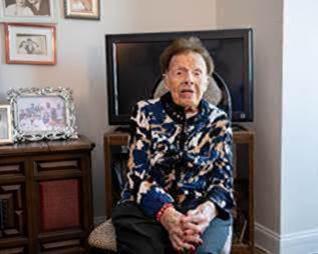
vors in Miami-Dade County, where the average age of clients is 94.5. As these survivors enter their final years, the urgency to provide them with compassionate care and preserve their stories has never been greater.
Mollie’s story is not only remarkable because of its length, but because of its message. “Mollie’s life is a powerful reminder that even in the face of unspeakable tragedy, the human spirit can endure,” says Natalie Herradon, Director of Case Management at JCS. “We are honored to care for her and to help preserve her legacy.”
This legacy was formally recog-
nized when the Miami-Dade Board of County Commissioners declared March 16 as “Mollie Horwitz Day.” The proclamation pays tribute to Mollie’s enduring contribution to the community and the broader cause of Holocaust remembrance.
As the nation observes Holocaust Survivor Day on June 4th, communities across the country pause to honor individuals like Mollie—living testaments to one of history’s darkest chapters. The day is not just about remembrance; it’s about responsibility. With the number of living survivors dwindling, it is our duty to support them and ensure that their stories are told and retold.
Florida, and particularly the Miami area, is home to one of the largest populations of Holocaust survivors in the United States. Many settled here after World War II, drawn by the promise of peace and the hope of rebuilding. Their presence has left a profound impact on the cultural and historical landscape of the region.
The Holocaust Memorial Miami Beach, established in 1990 by a group of survivors, stands as a haunting but powerful tribute to those who were lost. The memorial’s towering outstretched arm tattooed with numbers evokes both pain and remembrance, anchoring the community in its commitment to never forget.
Further north in Dania Beach, the Holocaust Documentation & Education Center educates thousands of students and visitors annually through exhibits, survivor
testimonies, and authentic artifacts—including a rail car used to transport victims to concentration camps and a U.S. Army tank used in liberation efforts.
Other institutions, like the Jewish Museum of Florida-FIU and the Goodman Jewish Family Services of Broward County, continue to preserve and share the stories of survivors through oral history, outreach programs, and emergency support services. These organizations ensure that survivors live not only with dignity but with the understanding that their lives have shaped generations.
The Jewish Community Services of South Florida (JCS), through its Holocaust Survivor Assistance Program, is at the front lines of this mission. Funded in part by the Conference on Jewish Material Claims Against Germany, the program provides everything from hot meals and healthcare to emotional support and social connection. For survivors like Mollie, these services are essential.
“The level of care and respect given to our clients is deeply personal,” says Herradon. “We’re not just providing services—we’re honoring a legacy.”
That legacy is carried in every visit from a caseworker, every meal delivered, every phone call returned. And it resonates in every story shared—stories that serve as both a warning and a guide for future generations.
In Mollie’s home, visitors are often struck by her warmth, her sharp wit, and the way her eyes light up when she speaks about her family. Despite all she has endured, she chooses joy. She chooses memory. And most importantly, she chooses to keep telling her story.
Her story—of survival, separation, and miraculous reunification—is more than history. It is a call to action. As we lose more survivors each year, the moral imperative grows clearer: support them, learn from them, and pass on their stories.
So, as South Florida commemorates Holocaust Survivor Day, it also celebrates the life of Mollie Horwitz—a woman who has not only lived through the unimaginable but who continues to inspire, educate, and remind us of the strength it takes to keep going.
Her voice joins a chorus of others in Florida and around the world—voices that must never be silenced. Because memory, when preserved with care and shared with purpose, becomes legacy. And legacy, when honored, becomes our collective future.
wwwYeshivaTuitionOrg.godaddysites.com




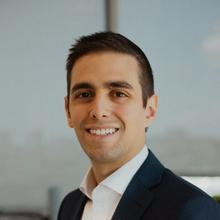






1 0 % O F F
Y O U R
F I R S T
V I S I T !




C o m e j o i n u s f o r a u n i q u e w i n e a n d d i n e e x p e r i e n c e !














Safrus Direct 786-579-0535 |office@safrusdirect.com
V&N Cleaning Service 561-860-0936
$10 off 1st cleaning, $10 off 2nd cleaning. We clean corners, not cut them!
Coolstar Air Service llc A/C Install & Repair (954) 200-1369 | coolstarair@yahoo.com
Fraida Perelstein, Nanny/Childcare/Elder Care: 40+ years of experience, seeks a full time or part time roles in the Miami area. Excellent references available; 347-446-1833 | funkymom63@gmail.com
SEAMSTRESS
Alterations, Dressmaking, including wedding clothes. Phone: (646) 413-4542
To place a Business Directory/Classified Listing contact: andrea@tsfcommunityvoice.com

List your local business, services available, real estate opportunities, Help Wanted, and more!
Basic listing: $10/weekName, number and email address
Enhanced listing: $25/week -
Up to 25 words (additional words $1/each)
Deadline: Tuesday at 4pm for next week's issue
Contact: andrea@tsfcommunityvoice.com
SUSHI PLATTERS
CATERING SETUP
LIVE SUSHI STATION
DELIVERY & PICKUP


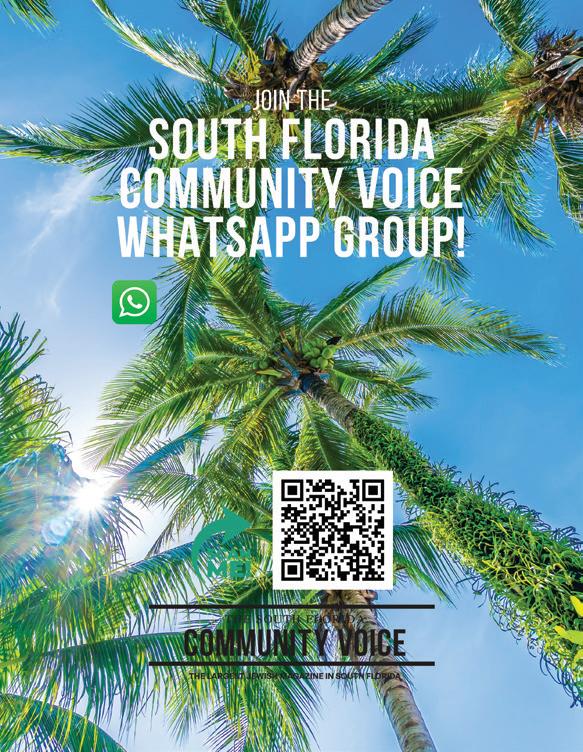


If you’re living an active, independent life in Palm Beach County, the idea of falling may seem far o;—something that happens to “other people.” But here’s the reality: falls are the leading cause of injury among older adults, and they often happen without warning— even to those who feel perfectly steady on their feet.
What’s more alarming is that changes in balance, coordination, and reflexes can happen gradually and silently. You might not notice your stride getting a little shorter, your reaction time slowing down, or your muscles weakening—until one small misstep results in a big disruption to your life.
The good news? Falls are not an inevitable part of aging. In fact, most are preventable with the right awareness and proactive steps. That’s where early intervention comes in—and where Florida Movement Therapy Centers (FLMTC) is proud to serve as a trusted partner in your wellness
journey.
Our fall-prevention programs are designed to help adults maintain—not just regain— control. Whether you’re trying to keep up with grandkids, golf a few rounds each week, or simply continue living independently, your balance and mobility deserve just as much attention as your heart, vision, and joints.
Here are five surprisingly simple ways to protect your balance—and your freedom:
1. Strengthen Your Ankles, Strengthen Your Foundation. Ankle strength plays a huge role in recovery from slips or uneven surfaces. Just a few heel raises and ankle rolls each day can protect you from instability.
2. Engage Your Core—Yes, Even Seated.
Balance starts in the center. Seated core exercises and posture practice can make daily movements—getting out of a chair,

reaching into cabinets—more secure.
3. Walk with Intention.
Try slow, purposeful walking patterns like side-steps or figure-8s in a safe space. It’s not about exercise—it’s about rewiring your brain and body to stay sharp.
4. Do a Home Walk-Through. Falls don’t always happen outside—they often happen at home. Simple changes like better lighting or moving rugs can make a big diference.
5. Schedule a Professional Balance Check.
You get checkups for your eyes and heart—why not your balance? FLMTC’s team provides fall-risk screenings that uncover issues you can’t see or feel on your own.
At FLMTC, we help independent adults stay independent—by staying one step ahead. Our programs are supportive, personalized, and designed to keep you moving confidently, not cautiously.
Don’t wait for a fall to make the first move. Reach out today to schedule a initial evaluation and learn more about how we’re helping Palm Beach County stay upright and active—one step at a time.
FLMTC is a multidisciplinary therapy center serving Palm Beach County with locations in Boca Raton and Boynton Beach. We specialize in physical, occupational, and speech therapy, oAering personalized care plans with a strong focus on fall prevention, balance training, and long-term mobility support. Our goal is to help every patient live safer, stronger, and more independently.



By Dr. Sarah Rosanel, MD FACC, Concierge Physician in Miami Florida - Internal Medicine Specialist/ Family Medicine and Cardiologist
In recent years, dietary supplements have become a booming industry, with billions of dollars spent annually on vitamins, minerals, herbs, and so-called “natural” remedies. From collagen powders to weight-loss capsules and “immune boosters,” these products are marketed as safe and effective ways to enhance health, delay aging, and improve energy. But as a physician, I want to share a critical reminder: just because something is available over the counter doesn’t mean it’s harmless.
The word “supplement” gives a false sense of security. Many people assume these products are simply food-based nutrients in pill form. In reality, many supplements act like drugs, with the power to alter body functions, interact with medications, and affect organs like the liver, kidneys, and heart.
Here’s the key difference: FDA-approved medications like aspirin, statins, or antibiotics are subject to rigorous testing. They must go through years of clinical trials to prove safety and effectiveness. Their manufacturing is tightly regulated. And, most importantly, their side effect profiles are well-documented and publicly disclosed. Physicians know what to monitor when prescribing them.
Supplements are not held to that same standard. In the United States, supplements are regulated more like foods than drugs. Manufacturers are not required to prove that their product works, or
even that it’s safe, before it hits the shelves. The FDA can only intervene after a supplement is shown to cause harm — and by then, the damage may be done.
The Risks Are Real: What the Research Shows
Multiple studies and medical reports have shown the dangers of unregulated supplement use. Here are just a few examples:
• Liver Failure and Hospitalizations: Herbal supplements, particularly those used for bodybuilding or weight loss, are among the leading causes of acute liver failure in the U.S. The NIH has documented dozens of cases of liver damage from products like green tea extract or kava.
• Drug Interactions: Supplements can dangerously interact with prescription medications. For example, St. John’s Wort, a popular remedy for depression, can reduce the effectiveness of birth control pills, blood thinners, and heart medications. Ginkgo biloba can increase bleeding risk when combined with aspirin or warfarin.
• Heavy Metals and Contamination: Since there is no mandatory testing, some supplements are contaminated with lead, arsenic, or mercury. Others are secretly spiked with prescription drugs like steroids, stimulants, or erectile dysfunction medications — none of which are listed on the label.
• Overdose and Toxicity: Unlike food sources, large doses of isolated nutrients can be harmful. Too much vitamin A can cause liver
damage and birth defects. Excessive vitamin D can lead to high calcium levels, kidney stones, and confusion. High-dose iron is toxic to children and can be fatal.
• Children and teens experimenting with fitness or energy supplements
• Pregnant women, who may take herbal remedies unaware of potential harm to the fetus
• Older adults managing multiple chronic illnesses, where interactions can be life-threatening
• People with liver or kidney disease, who cannot process these compounds safely
1. Talk to Your Doctor before starting any supplement — even if it seems “natural.”
2. Be wary of grand claims, like “cures cancer” or “boosts immunity instantly.” If it sounds too good to be true, it probably is.
Supplements may not require a prescription, but they are not without risk. They are biologically active compounds that can alter your body’s chemistry, interact with medications, and even cause serious harm. Unlike aspirin, antibiotics, or insulin, their side effects are not fully studied, disclosed, or monitored.
As a community, we must treat supplements with the same caution and respect we give any medication. Being proactive, informed, and medically supervised is the safest path toward health.
Dr. Sarah Rosanel is dedicated to educating the community about safe, evidence-based health practices. She practices as a concierge physician based in Miami, FL, specializing in personalized healthcare tailored to the unique needs of her patients. With a holistic approach that blends traditional medicine, lifestyle interventions, and functional medicine, she empowers individuals to achieve optimal health and well-being.
As an expert in Concierge Medicine & Cardiology, Dr. Rosanel integrates cutting-edge medical treatments with holistic methodologies, ensuring comprehensive care that goes beyond symptom management to address the root causes of health concerns.
Beyond her medical practice, Dr. Rosanel is a devoted mother to Ariel, Zev, and Shirley, balancing her passion for healing with family life.
* Book an Appointment: Call or text (646) 467-4368 | * Miami, Florida | * info@DrRosanel.com





By Jamie Geller
• 25 MIN DURATION • 15 MIN COOK TIME • 10 MIN PREP TIME • 6 SERVINGS •
My favorite pasta sauces are alfredo and vodka. I find it hard to choose between them. I have been known to order both at restaurants. Hey, sometimes a girl just has to help herself! This lighter version of the classic alfredo goes down just as smoothly as the original.
Ingredients
• 1 pound pasta, fettuccine or spaghetti
• 1 cup low-fat plain Greek yogurt
• 1 cup low-fat ricotta cheese
• ½ cup Tnuva parmesan cheese
• 2 tablespoon Tnuva unsalted butter, melted
• ½ teaspoon lemon zest
• Kosher salt
• Freshly ground black pepper

1. Bring a large pot of salted water to a boil and cook pasta according to package directions. Drain well, reserving about ½ cup of the pasta water.
2. In a blender or food processor, combine yogurt, ricotta, parmesan, butter, and lemon zest. Blend for 1 to 2 minutes or until completely smooth.
Stream in reserved pasta water if desired to achieve desired taste and consistency.
3. Toss the cheese and yogurt mixture with the cooked pasta, return to the pot and cook over low heat for 5 minutes or until just warmed. Season with salt and pepper to taste. Divide between bowls and serve warm.
Jamie Geller is the Chief Media and Marketing Officer at Aish. She is also a bestselling cookbook author, celebrity chef, television producer, and businesswoman. She’s the author of eight cookbooks and the founder of Kosher Media Network.











A Relatively New Concept: The idea of a long summer vacation from school is a fairly modern invention. It largely originated in the United States in the 19th century as urban areas became increasingly hot and families with means would escape to cooler climates, leading to lower school attendance.
Not Just for Farming Anymore (If It Ever Was!): A common myth is that summer vacation began to allow children to help with summer harvests. However, historically, the busiest farming times were spring planting and fall harvesting. Many rural schools actually held sessions during the summer.
Global Variations: While summer break is common worldwide, its length varies significantly. Some countries have breaks as long as 13 weeks, while others have as few as four to six weeks. And, of course, in the Southern Hemisphere, “summer” vacation falls during December and January!
The Eiffel Tower Grows Taller: Thanks to thermal expansion, the iconic Eiffel Tower in Paris can actually grow about six inches taller during the warmer summer months as the metal structure expands in the heat.
Ice Cream Month: July is National Ice Cream Month in the United States, a fitting tribute to one of summer’s most popular treats. This was officially declared by President Ronald Reagan in 1984.
Popsicles Were an Accident: The beloved
summer cool-down treat, the popsicle, was invented by an 11-year-old boy named Frank Epperson in 1905. He accidentally left a mixture of soda powder and water with a stir stick outside on a cold night, and the rest is history!
“Dog Days of Summer”: This phrase, referring to the hottest period of summer (typically July 3rd to August 11th in the Northern Hemisphere), actually has astronomical roots. It refers to the period when Sirius, the “Dog Star,” appears to rise just before the sun.

More Movie Blockbusters: Summer is traditionally the biggest season for movie releases. With kids out of school and families looking for entertainment, Hollywood often saves its biggest blockbusters for the summer months.
Travel Peaks: Unsurprisingly, summer is the busiest travel season in many parts of the world. National parks, beaches, and amusement parks see a significant surge in visitors. In 2025, Las Vegas was named the top domestic summer destination for U.S. travelers by Tripadvisor.
Firefly Mating Season: For many, the magical glow of fireflies (or lightning bugs) is a quintessential summer sight. Summer is the primary mating season for these bioluminescent beetles, as they use their light to attract partners.

First place: $30 gift card | Second place: $20 gift card | Third place: $10 gift card
Email your artwork to editor@tsfcommunityvoice.com
Make sure to include your name, age and city. Entries must be received by June 9.
This type of contest encourages creativity, education and community engagement. It allows kids to express themselves through art, and it also provides an opportunity for their work to be showcased in the magazine.

Sponsored by: SMASH HOUSE BURGERS smashhouseburgers.com (305) 351- 9545









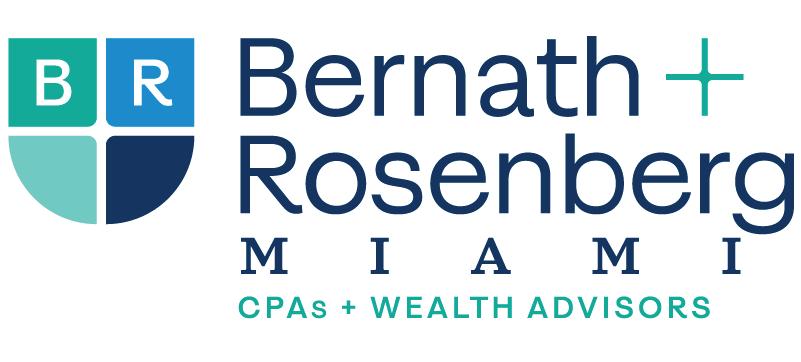
Granted, it’s a somewhat random time in 2025 to be writing a “Year in Review” piece, but that’s not what this article is about. I just completed the longest year of my life … the 12-month mourning period for the loss of my father. It has been a long year. A very long year
After the shloshim I took it upon myself to do Mishnayos. I wasn’t sure that it would last. Whenever I felt like giving up, I’d remember my immigrant father, who never went to Yeshiva, diligently doing his Daf every day. And it wasn’t just with Daf Yomi; it was with anything he did. And that’s what drove me to do this for him.
Another thing I did for him was recite the Kaddish, which I said more than 2,000 times over the past 11 months. But I’m not sure whether that was for him or for me. Because without fail, every time that I said the words “Amein, Yehei Shmei Rabbah…,” I would close my eyes for a second or two, and images would appear. It was always the same three or four pictures or memories that would flash before me – repeatedly for 11 months. The photos were from the last year of his life. And for a second or two, I got to see him and be with him. That was the part of davening I cherished most.
There was a part that I didn’t. Like wondering: what happened to all those tefillos we said for my father? All the Tehillim? All the heartfelt prayers? A few weeks ago, my sister sent me a shiur by Rabbi Joey Haber on Teffilah. He talks about how the Gemorah says that
By Shmuel Shayowitz
no tefillah goes unanswered. But we obviously know that it’s not true. Unfortunately - People get sick. People suffer. People die.
When I said my last Kaddish, as I did every davening, I closed my eyes for Yihei Shmei Rabba. Only this time, I didn’t see the usual pictures as I did before. It was a different picture. An image that I never saw before. It was with a backdrop that I had never seen before. It was a new image of my father holding his two hands over my head and giving me a bracha.
And that’s when I remembered the punchline of Rabbi Haber’s shiur: Tefillah doesn’t necessarily change the outcome. It is meant to change the person.
And perhaps that is what this year did. It taught me that grief doesn’t disappear. It transforms. And that death doesn’t end a life - it amplifies it. It puts every memory into sharper focus. So while the outcome didn’t change, I wish to somehow believe that I did!
I believe my father was handing me something. A blessing. A mandate. A message: You can move forward now - not by forgetting, but by becoming. And that’s what I wanted and needed. I didn’t want my father’s legacy to stay frozen in stories or regret.
I want his legacy to live. I want it to shape the way I parent. The way I daven. The way I show up in this world. Because everything he was - his integrity, his honesty, his humility, his humor, his strength … these aren’t just things that I want to remember … They are things I
want to become. I want my children to know that they come from a greatness - quiet, simple, and sincere greatness. That their Zaidy didn’t just leave behind a good name - he left behind a path. A way to live. A way to believe. A way to behave.
Grief doesn’t operate on a calendar. The milestones … the Shiva, the Shloshim, the Unveiling, the Yahrzeit - they don’t signal closure. They symbolize a journey. One that’s often personal, quiet, and lonely - but one that, if we let it, can be transformative. I embrace the beginning of a new life path of carrying him forward. Of becoming the son he raised me to be and of passing that blessing onto the next generation. Yehi zichro baruch.
Would you rather relive one perfect day from your past or get a glimpse of one day from your future? I’d love to hear your answer! Please let me know if you have a good “Would you rather” question, and we will highlight your submission.
Shmuel Shayowitz (NMLS#19871) is a highly regarded Real Estate & Finance Executive, Writer, Speaker, Coach, and Advisor. He is President and Chief Lending Officer of Approved Funding, a privately held national mortgage banker and direct lender that has facilitated over $3 billion in mortgage funding. Shmuel has over twenty years of industry experience, holding numerous licenses and accreditations, including certified mortgage underwriter, licensed real estate agent, residential review appraiser, and accredited investor, to name a few. Shmuel has successfully navigated through many changing markets and business landscapes, making his market insights and experience well-coveted within the real estate industry. He can be reached via email at Shmuel@ approvedfunding.com.







HOME EQUITY, MINUS THE HEADACHES. BECAUSE LIFE’S COMPLICATED ENOUGH.
UNLOCK A HASSLE-FREE HOME EQUITY LINE OF CREDIT (HELOC) WITH OPTIMUM BANK.
With South Florida home values rising, now’s the time to put your equity to work. Whether it’s camp tuition, a new A/C, or fixing that ceiling leak before hurricane season — an Optimum HELOC could be your solution.
At Optimum, we don’t do runarounds or phone trees.
For over 20 years, we’ve kept banking local, human, and refreshingly straightforward, with branches in:
DEERFIELD | FT. LAUDERDALE | NORTH MIAMI BEACH NO CALL CENTERS. NO HIDDEN FEES. JUST REAL NEIGHBORS WHO: KNOW THE COMMUNITY OFFER CLEAR TERMS PROVIDE GREAT LOAN OPTIONS
From supporting local schools and nonprofits to sponsoring concerts and Chulent CookOffs, Optimum is proud to help turn South Florida’s growth from a headline into a hometown. Our HELOC helps homeowners access their home’s value — while backing the people and institutions that make our community thrive.
Member FDIC. Equal Housing Lender. Terms and conditions apply. We don’t pick roof tiles, but we’d love to hear your choice.
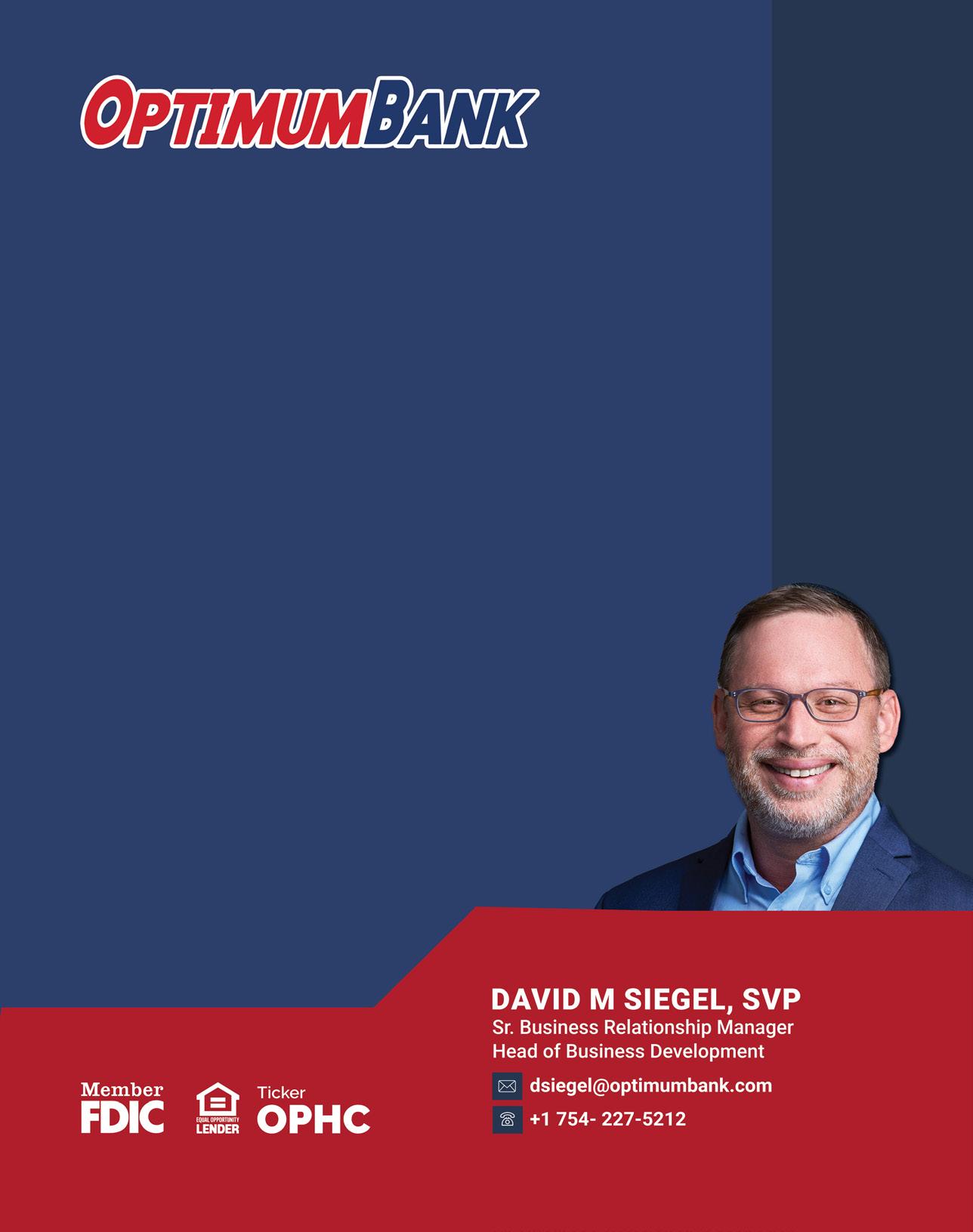
LET’S TURN YOUR EQUITY INTO SOMETHING GREAT WITH A HELOC FROM OPTIMUM.
DOVID SIEGEL, SVP Head Of Business Development
Call us today 754-227-5212 Visit [www.optimumbank.com] email dsiegel@optimumbank.com or stop by your neighborhood branch